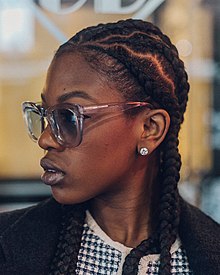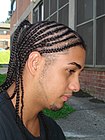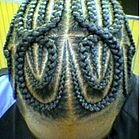Cornrows

Cornrows (sometimes called canerows) are a hairstyle. They are braids with the hair braided very close to the skin of the head. The braids are made with an underhand, upward motion. This makes a raised row. Cornrows usually have simple, straight lines, like the rows of corn in a cornfield, but they can have patterns instead.
Cornrows can have beads, cuffs, or cowrie shells in them. It can take hours to make a cornrow hairstyle.[1]
Cornrows can stay in for weeks if the person washes their head well. Cornrows are also a protective hairstyle: People with African hair wear them to help their hair grow without breaking. However, if the braids are too tight, kept in for too long, or put in hair that can't keep them, the hair might fall out. This is called traction alopecia.[2]
Over the centuries, people from many parts of the world have put their hair in cornrows. In the 20th and 21st centuries, cornrows are more common in people with African ancestors. This has led to accusations of racism and discrimination and to laws about cornrows and other protective hairstyles.
History[change | change source]

The oldest known human-made things that look like cornrows or braids are statues: the Venus of Brassempouy[3][4] and the Venus of Willendorf,[5][6][7] which were made 25,000-30,000 years ago. People found them in what is now France and Austria.
There are also pictures of women with cornrows in Stone Age paintings in the Tassili Plateau in the Sahara. These pictures could be as old as 3000 B.C. Ancient Cushitic people of the horn of Africa wore this style of braids as long ago as 2000 B.C.[8] The traditional hairstyle of Roman Vestal Virgins had cornrows.[9][10][11]
In Africa, especially the Horn of Africa and West Africa, women put their hair in cornrows. Men wear cornrows too. Ancient Greek sculpture and artwork from the 5th century b.c.e. shows men warriors and heroes wearing cornrows. Artwork and statues from the Middle East and Mediterranean from the 3rd and 4th century b.c.e. also show cornrows were common. Men in 19th century Ethiopia wore cornrows: where warriors and kings such as Tewodros II and Yohannes IV were shown wearing cornrows.[source?]
The name also refers to either the corn fields or sugar cane fields in the Caribbean.[12]

Cornrow hairstyles in Africa also cover a wide social terrain: religion, kinship, status, age, racial diversity, and other attributes of identity can all be expressed in hairstyle. Just as important is the act of braiding, which passes on cultural values between generations, expresses bonds between friends, and establishes the role of professional practitioner.[13]
Cornrows became common again in the United States in the 1960s and 1970s and again during the 1990s and 2000s. In the 2000s, some athletes wore cornrows, including NBA basketball players Allen Iverson, Rasheed Wallace, and Latrell Sprewell.[14]
Controversy[change | change source]

There have been arguments in the United States about cornrows, dreadlocks, and other hairstyles. Some employers and schools[15] say they are not good and made rules against wearing them.[14] Employees and civil rights groups said that this meant the employers had cultural bias, meaning that they were prejudiced against the cultures that cornrows come from, mostly American black culture. There have been lawsuits.[16]
In 2011, the High Court of the United Kingdom, saw a test case. The Court said a school's decision stop students with cornrows from entering the school was wrong. The court ruled said the student wearing cornrows could keep wearing them because it was his cultural tradition. The court said that it was sometimes all right for schools to make rules against hairstyles. For example, they said schools could forbid skinhead gangs' shaved heads.[17]
In the US state of California, the CROWN Act was passed in 2019. It said that discrimination based on hair was against the law.[18] Other states have passed CROWN acts too.
Gallery[change | change source]
-
Styled cornrows
-
Cornrows
-
Artistic braiding
Related pages[change | change source]
References[change | change source]
- ↑ "Cornrow Braid Styles". Africanamericanhairstyling. Archived from the original on 26 July 2018. Retrieved 11 August 2018.
- ↑ "Braiding 'can lead to hair loss'". BBC News. 24 August 2007. Retrieved 30 April 2010.
- ↑ Randall White (December 2006). "The Women of Brassempouy: A Century of Research and Interpretation" (PDF). Journal of Archaeological Method and Theory. 13 (4): 251–304. doi:10.1007/s10816-006-9023-z. S2CID 161276973..
- ↑ "Echoes of the Past: Prehistoric Wonders in Southern France". France Today. 30 September 2021. Retrieved 16 May 2022.
- ↑ "Woman from Willendorf" Archived 2007-10-05 at the Wayback Machine. Christopher L. C. E. Witcombe, 2003: "The rows are not one continuous spiral but are, in fact, composed in seven concentric horizontal bands that encircle the head and two more horizontal bands underneath the first seven on the back of the head."
- ↑ Shaw Nevins, Andrea (2006). The embodiment of disobedience : fat black women's unruly political bodies. Lanham, MD. ISBN 978-0-7391-5457-1. OCLC 856869915.
{{cite book}}: CS1 maint: location missing publisher (link) - ↑ Shell, Ellen Ruppel (2003). The hungry gene : the inside story of the obesity industry (1st Grove Press ed.). New York: Grove Press. ISBN 0-8021-4033-5. OCLC 53434322.
- ↑ Willie F. Page, ed. (2001). Encyclopedia of African history and culture: Ancient Africa (prehistory to 500 CE), Volume 1. Facts on File. p. 36. ISBN 978-0816044726.
- ↑ León, Vicki (2013). Working IX to V : orgy planners, funeral clowns, and other prized professions of the ancient world. New York. p. 18. ISBN 978-0-8027-1862-4. OCLC 879285569.
{{cite book}}: CS1 maint: location missing publisher (link) - ↑ "Oldest Roman Hairstyle Recreated for First Time". LiveScience. 9 January 2013. Retrieved 13 February 2019.
- ↑ "Ancient Roman Vestal Virgin hairstyle re-created for very first time". Gizmodo. 11 January 2013. Retrieved 16 May 2022.
- ↑ Charlotte Mensah (29 October 2020). Good Hair: The Essential Guide to Afro, Textured and Curly Hair. Penguin Books Limited. p. 42. ISBN 978-0-241-98817-6.
- ↑ "History of Cornrow Braiding: African Origins 1.b". Csdt.rpi.edu. Archived from the original on 23 June 2015. Retrieved 20 June 2015.
- ↑ 14.0 14.1 Sherrow, Victoria (2006). Encyclopedia of Hair: A Cultural History. Greenwood Publishing Group. p. 97. ISBN 9780313331459.
- ↑ Harris, Sherry. "Cornrows: History, Controversy & Freedom of Expression". Sherry's Life. Archived from the original on 14 August 2016. Retrieved 28 August 2016.
- ↑ Alison Dundes Renteln (2005). The Cultural Defense. p. 143. ISBN 9780195154030. Retrieved 10 August 2011.
- ↑ "School braids ban 'not justified'". The Independent. 17 June 2011. Retrieved 17 June 2011.
- ↑ "California becomes first state to ban discrimination against natural hair". www.cbsnews.com. 4 July 2019. Retrieved 13 May 2021.
Other websites[change | change source]




